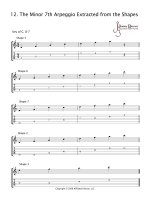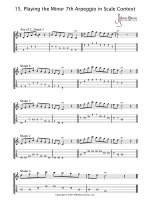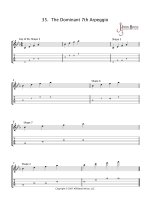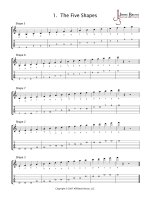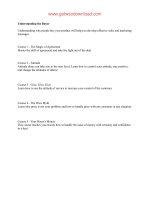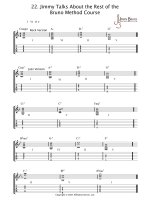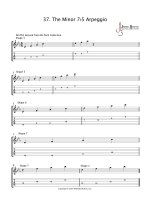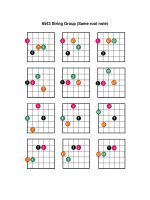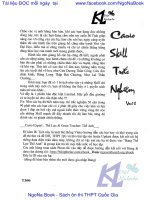the step by step guide to mastering the design and copy of ctas tủ tài liệu bách khoa
Bạn đang xem bản rút gọn của tài liệu. Xem và tải ngay bản đầy đủ của tài liệu tại đây (1.41 MB, 36 trang )
1
mastering the design & copy of calls-to-action
the step-by-step guide to
mastering the
design & copy of
calls-to-action
GO!
How to Optimize
the Design &
Copy of Your
Calls-to-Action
A publication of
Share This Ebook!
www.Hubspot.com
2
mastering the design & copy of calls-to-action
IS THIS BOOK RIGHT FOR ME?
Not quite sure if this ebook is right for you? See the below description to determine if
your level matches the content you are about to read.
INTRODUCTORY
Introductory content is for marketers who are new to the subject.
This content typically includes step-by-step instructions on how
to get started with this aspect of inbound marketing and learn
its fundamentals. Read our introductory ebook, “How to Create
Effective Calls-to-Action.”
INTERMEDIATE
This ebook!
Intermediate content is for marketers who are familiar with the
subject but have only basic experience in executing strategies and
tactics on the topic. This content typically covers the fundamentals
and moves on to reveal more complex functions and examples.
After reading it, you will feel comfortable leading projects with this
aspect of inbound marketing.
ADVANCED
Advanced content is for marketers who are, or want to be, experts
on the subject. In it, we walk you through advanced features of
this aspect of inbound marketing and help you develop complete
mastery of the subject. After reading it, you will feel ready not only
Share This Ebook!
www.Hubspot.com
to execute strategies and tactics, but also to teach others how to
be successful.
3
mastering the design & copy of calls-to-action
the step-by-step guide to
mastering the design & copy of
calls-to-action
by Magdalena Georgieva
Maggie Georgieva is an inbound marketing
manager at HubSpot, responsible for the
company’s marketing content offers, such as
ebooks and webinars (including the world’s
largest webinar).
Previously, Maggie was on HubSpot’s email
marketing team, managed the company’s
landing page creation and optimization, and
jump started the production of HubSpot’s
customer case studies.
Maggie is a regular blogger for the HubSpot
blog and has contributed to other sites and
publications, such as MarketingProfs, Brian
Solis’ blog, BostInnovation.com and The St.
Petersburg Times.
Share This Ebook!
www.Hubspot.com
Follow me on twitter
@mgieva
4
mastering the design & copy of calls-to-action
HubSpot’s All-in-One
Marketing Software
HubSpot brings your whole marketing
world together in one, powerful, integrated
system.
3
3
3
3
Get Found: Help prospects find you online
Convert: Nurture your leads and drive conversions
Analyze: Measure and improve your marketing.
More: See marketplace for apps and integrations
Request A Demo
Share This Ebook!
www.Hubspot.com
Video Overview
U q
Lead
blogging &
Generation
social media
M s
Email &
Search
Automation
optimization
g Y
Lead
Marketing
management
analytics
5
mastering the design & copy of calls-to-action
COntents
Master the Design of Compelling Calls-to-Action
/8
Write Call-to-Action Copy That Gets Visitors Clicking /18
optimize calls-to-action through a/b testing
Conclusion & additional resources/33
Share This Ebook!
www.Hubspot.com
/27
6
“
mastering the design & copy of calls-to-action
Calls-to-action (CTAs) should be
used in each and every one of your
marketing tactics.
”
Calls-to-action (CTAs) are one of the key lead generation elements, and they
should be used in each and every one of your marketing tactics: emails,
social media updates, press releases, trade shows ... the list goes on. In
fact, whenever you want to ensure your team is moving in the right direction,
pose the question, “What’s the call-to-action we’re using to drive people’s
behavior?”
This question will guide you in thinking through each of the steps in the
sales cycle, from brand awareness to purchase. Before you produce a
marketing video, for example, ask yourself what you want viewers to do after
watching it. Before you post an update to Facebook or Twitter, consider what
options for engagement you are giving to your fans and followers.
Share This Ebook!
www.Hubspot.com
7
mastering the design & copy of calls-to-action
Naturally, the call-to-action won’t always be to purchase your product
or service. It can certainly lead people in that direction, but it will rarely
follow as a direct result of an isolated marketing tactic. That is why you
should view your marketing as an integrated system that combines
different channels and assets. Social media and blogging might do
wonders with attracting traffic to your online real estate, but you need
lead generation tools to capture that traffic and marketing automation
to nurture it down the sales funnel.
In this context, calls-to-action play a critical role for getting to each step
and moving ahead. In this guide we will cover the three major steps
in which you can improve your calls-to-action and optimize them for
maximum conversions. We’ll start by looking at effective CTA designs,
then continue by exploring CTA copy options and wrap up with some tips
on CTA split (A/B) testing. After going through each of these sections,
you’ll be in a good shape to increase call-to-action clickthrough rates
and visitor-to-lead conversions.
Share This Ebook!
www.Hubspot.com
8
mastering the design & copy of calls-to-action
CHAPTER 1
Master the
Design of
Compelling
Calls-toAction
Share This Ebook!
www.Hubspot.com
9
mastering the design & copy of calls-to-action
9 tips on
call-to-action design:
Once you have a strategy in mind for which calls-to-action you’ll feature on your website, you’ll
probably start obsessing over their design. In this section, we present you with some guidelines
to master the design of successful calls-to-action.
1
size matters: make it big
The goal of your call-to-action is to attract the attention of website visitors,
and one way to convey its importance is by enlarging it. “You want your
button to be large enough to stand out without overwhelming the design,”
writes graphic designer Cameron Chapman.
Size shouldn’t be determined independently of other
factors -- it is tightly related to the context of the page
and the other characteristics of your call-to-action. For
instance, the CTA will naturally be large if it includes
a graphic or an image that strengthens the message.
This is what we do for HubSpot’s blog: the call-toaction placed at the end of each article is bigger than
your standard CTA button because it is contextualized
and adds value to the article. Visit our blog to see a
bunch of examples!
Share This Ebook!
www.Hubspot.com
10
2
mastering the design & copy of calls-to-action
Spacial effect
You know how they say that, sometimes, less is more? Well, that can
definitely be true for calls-to-action. If you want to attract more attention
to your CTA, you should give it some breathing space. Don’t crowd the
language unless the information around it is key to taking the action.
Simple logic dictates the ‘amount of white space’ decision. Separating the CTA from the rest of
the content on a web page will mean it’s a separate item. If there is a tight connection between
the call-to-action and some other web page element, then maybe there should be less white
space between the two.
“The more white space there is in between a call-to-action button versus a surrounding element,
the less connected they are,” writes Jacob Gube in SmashingMagazine. “Therefore, if you
have other elements that can help convince users to take action, reduce the white space in
between those elements and the CTA.” Another tactic here is to fill your call-to-action with
warm background colors, such as red and orange, which appear larger than colors suggesting
coldness, blue and green. Warm colors appear closer to the viewer.
Share This Ebook!
www.Hubspot.com
11
3
mastering the design & copy of calls-to-action
placement
Your call-to-action needs to be above the fold so viewers don’t have to
scroll down in order to spot it. According to an Eyetrack III study, the best
placement of online ads is in the top and left position. This tactic, too, is
dictated by simple logic. In the English language, we start reading from left
to right and from top to bottom.
Copywriter Dean Rieck suggests that
once your readers get used to a particular
placement, they might start ignoring the
call-to-action or ad. “So even the prime
upper left area won’t work so well if you
always put ads there,” he writes. The most
effective placement could also depend on
the context of the rest of the page, so make
sure you do some testing.
For instance, test the ideal top and left position versus a placement in which the call-to-action
is right beneath the offer description. Run an A/B test to see if you get more clicks, and pick a
winner.
Share This Ebook!
www.Hubspot.com
12
4
mastering the design & copy of calls-to-action
contrast
Contrast is one of the most powerful graphical techniques you can apply to
calls-to-action. The fastest way to grab someone’s attention is by making
your CTA stand out from the rest of the page and making it dominant. To
achieve that, pick a color for your button that contrasts the background.
There has been a huge debate revolving around usage of the color red for call-to-action design.
Some marketers argue that red can increase click-through rates significantly. Others explain that
the context of the web page should determine the color. Whether you decide to use the color
of fire, passion, and also the international stop signal or not, be mindful of your overall website
design. While you want to keep the colors contrasting, make sure all of them fit in with your
general website color scheme and avoid using patterns.
By using visually different font, you can also achieve contrast with your call-to-action: some
words might be larger or more emphasized than others. Just ensure that the CTA is easy to read.
Share This Ebook!
www.Hubspot.com
13
5
mastering the design & copy of calls-to-action
interactive effects
Surely, you’ve seen calls-to-action that change when you hover over them
with your mouse. Such hover effect creates a perception that the CTA is
instantly clickable and the visitor is one step closer to taking the action.
Using hover animation, you can make your buttons change color and brightness. You can also
give them a shadow or have them zoom in or out. There are many Adobe Photoshop tutorials
out there that can teach you how to create such a hover animation and help you create an
even more irresistible call-to-action. Other design styles that you can apply to your call-to-action
include drop shadow, text and button bevels and gradient colors. All these options are available
through HubSpot’s Call-to-Action Builder.
Share This Ebook!
www.Hubspot.com
14
mastering the design & copy of calls-to-action
6
try Unconventional Shapes
Most calls-to-action have the same shape: that of a standard rectangular
box. Shay Howe, designer and user interface engineer at Groupon,
recommends that you give your CTA shape rounded or circular corners to
make it more “button-like.”
Square corners, he writes, may signal to visitors that the CTA is an ad or banner, and they might
therefore avoid it.
Sometimes you will encounter calls-toaction that have more unconventional
shapes. For instance, they might be
oval, star-like or assuming the contours
of another object. This creative
approach creates an element of
surprise and might prove to be effective
in increasing click-through rates.
“
Experiment with call-to-action
shapes that are rare, asymmetrical,
and out of the ordinary.
Share This Ebook!
www.Hubspot.com
”
15
7
mastering the design & copy of calls-to-action
create a sense of direction
Some of the most successful calls-to-action out there have arrows pointing
at them. It creates a sense of direction and guides the visitor to the
important element on the page. This is a way of prioritizing information
and creating a flow.
In fact, HubSpot Social Media Scientist Dan Zarrella, found out that if you have a picture of a
human looking at a lead-capture form or call-to-action on a page, that’s where the eye of the
visitor will also shift to. So don’t add images of people who stare right at your audience; make
them stare at what your audience should look at.
Share This Ebook!
www.Hubspot.com
16
8
mastering the design & copy of calls-to-action
on multiple Calls-to-action
Often times, you have two or three competing actions that you would like
your website visitors to take. For instance, you might want them to request
a consultation and try your product.
Or you might want them to sign up for your email newsletter and download a whitepaper. Decide
which call-to-action has higher priority, and give it more prominent placement and a bigger size.
Also, keep in mind that the context of your page will affect click-through rates, so make sure
there is a clear alignment between your call-to-action and the content around it.
Make sure you use different colors to
illustrate which alternative is more desirable.
For instance, on HubSpot’s homepage,
you will see that in the center we have
three calls-to-action that, from left to right,
decrease in importance. The key call-toaction, “Start A Free Trial,” is in orange,
followed by the grey “Marketing Assessment”
CTA, and then the “See the Software” CTA,
which is just hyperlinked text.
Share This Ebook!
www.Hubspot.com
17
mastering the design & copy of calls-to-action
9
“
focus on text, not graphics
The Eyetrack III study also showed that in ads, website visitors read more
text content than graphical content.
People looking for information are
looking for text, not pictures.
”
— Dean Rieck, Copywriter
Make sure your wording is clear, specific, and action-oriented. In the next chapter, we will cover
some copywriting tips in more detail
While you should focus on your call-to-action text, don’t forget that graphics can help convey
meaning and strengthen your message. They are especially useful in explaining a concept that is
hard to explain with words alone.
Share This Ebook!
www.Hubspot.com
18
mastering the design & copy of calls-to-action
CHAPTER 2
Write Callto-Action
Copy That
Gets Visitors
Clicking
Share This Ebook!
www.Hubspot.com
19
mastering the design & copy of calls-to-action
“
Being able to articulate ideas
clearly is key to capturing the
attention of prospects.
”
Good writing matters in marketing; being able to articulate ideas clearly
is key to capturing the attention of prospects. This rule is crucial when
it comes to calls-to-action. If the copy you craft doesn’t draw visitors in,
that can hurt your click-through rate, lead conversions, and ultimately,
sales.
Visitors focus on the words in text ads more than on the graphics. So
what makes your copy compelling? “The number one rule,” says Dr.
Flint McGlaughlin, Director of MECLABS, “is clarity trumps persuasion.”
In this section, we will discuss some key copywriting lessons you should
apply to the process of crafting successful calls-to-action.
Share This Ebook!
www.Hubspot.com
20
mastering the design & copy of calls-to-action
5 tips on
call-to-action copywriting:
1
start with subjects & verbs
The very first piece of advice in the classic book Writing Tools encourages
writers to start sentences with subjects and verbs. In the English language,
we read from left to right, and verbs and subjects help us to quickly glean
the meaning of a sentence.
As basic as these tips may be, acknowledging them when crafting your online call-to-action is
crucial when the attention of readers is more elusive than the shadow of a flapping bird.
Surprisingly, a lot of companies don’t
seem to consider this in their call-to-action
copywriting. A quick visit to The New York
Times’ website revealed a bunch of paid
ads that were missing verbs or hiding them
in the bottom right corner. For example,
check out the screenshot of an exhibit ad
from the site’s Arts section.
This call-to-action copy could be drastically improved by adding a vibrant verb at the very top,
maybe something along the lines of “Peek into the world of dead sea scrolls.”
Share This Ebook!
www.Hubspot.com
21
mastering the design & copy of calls-to-action
By not including a verb in the CTA copy, you aren’t prompting readers to take action, which can
hurt the click-through rate of your call-to-action and negatively impact conversions.
“
Verbs are the part of
speech that generate the
most shares on Twitter.
”
In fact, verbs are the part of speech that generate the most shares on Twitter, which HubSpot
Social Media Scientists Dan Zarrella reported in his Science of Social Media research. Verbs
beat adverbs, adjectives, and nouns in terms of their potential to attract Twitter shares!
Share This Ebook!
www.Hubspot.com
22
2
mastering the design & copy of calls-to-action
include numbers
The internet overflows with guesswork and vague statements. That’s why
using data and numbers is a great way to demonstrate that your message
is clear and to-the-point.
Numbers are a great way to break
through the clutter of ambiguity, be
specific about your offer, and set the
right expectations. A number tells
visitors exactly what they’re going to get,
how much of it, for how long, etc. This
technique has proven successful not
only for call-to-action copy, but also for
blog post titles, press release headlines,
and email subject lines. In fact, in The
Science of PR, Dan Zarrella discovered
that including digits in your press release
headline can help increase total views.
What numbers can you include in your CTA copy? You can add the page length of the whitepaper
you offer, mention a specific discount, or list the numerical impact or benefit of a particular
resource you are providing. For instance, HubSpot’s call-to-action for joining our email list is
“Get the world’s best marketing resources right to your inbox! Join more than 817,000 inbound
marketers!”
Share This Ebook!
www.Hubspot.com
23
mastering the design & copy of calls-to-action
use adverbs sparingly
3
Most adverbs can be recognized by their “ly” ending, e.g. “finally,”
“unfortunately,” and “quietly.” However, there are different types of
adverbs (in relation to direction, time, degree, and manner), and their
function is to modify “constituents other than nouns.”
They have no fixed position in a sentence. For instance, you can place the word “finally” at
“
different places in the same sentence.
Marketers should use adverbs
in their call-to-action only if it
aids in the understanding of
the message.
”
Adverbs could help you shorten the copy: you can replace “to the extreme” with “extremely”;
“with ease” with “easily”; and “in this place” with “here.” Some of the most frequently
used adverbs by marketers in calls-to-action include terms like “now,” “fast,” “today,” and
“here.”Actually, adverbs are the part of speech that gets the fewest number of shares on Twitter,
according to Dan Zarrella’s Science of Social Media research. They are behind adjectives, nouns,
and verbs in shareability.
Share This Ebook!
www.Hubspot.com
24
4
mastering the design & copy of calls-to-action
length: 90-150 characters
The standard advice for calls-to-action has been to keep them short and
concise. Don’t write convoluted copy that will take your visitor a long time
to read.
Not surprisingly, this holds true for other marketing activities, such as emails and press releases.
“With plenty of competition in the inbox, on the web, and elsewhere, it is wise to assume you
have a limited opportunity to catch and keep a recipient’s attention,” writes Simms Jenkins, CEO
of BrightWave Marketing, about emails.
However, your CTA should
contain enough information
about the benefits and
specifics of your offer. Don’t
shorten it for brevity’s sake.
In fact, start by writing out
a few full sentences that
clearly convey the offer’s
appeal. Then, remove words
that don’t contribute to your
core message.
In The Science of PR, Dan Zarrella reported that the most engaging press release headlines are
between 90 and 150 characters. Try to fit your call-to-action copy in these limits, and see how
readers react.
Share This Ebook!
www.Hubspot.com
25
5
mastering the design & copy of calls-to-action
don’t use technical terms
The language in your calls-to-action will most likely reflect industry-specific
knowledge. However, there are some best practices that hold true for all
CTA copy, regardless of industry.
The terminology that works well for attracting views to blog posts implies expertise and thought
leadership. According to The Science of Blogging, some of the words that are most viewed in
blog posts include “insights,” “analysis,” “answers,” “questions,” “advice,” “review,” “why,”
“product”, “top,” and “best.” These words suggest that the piece of content can improve the
reader in some way. The same logic can be applied to crafting call-to-action copy. Emphasize the
benefits of the offer and how it can make your prospects smarter.
what to use:
2
insights
review
advice
analysis
answers
Share This Ebook!
www.Hubspot.com
why
